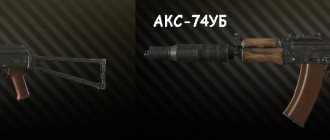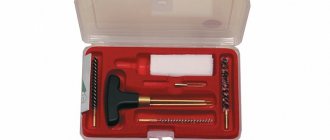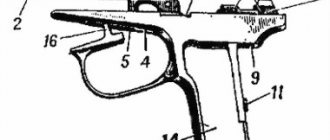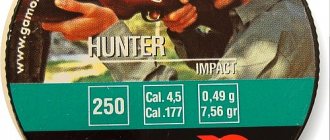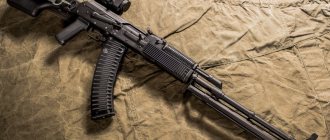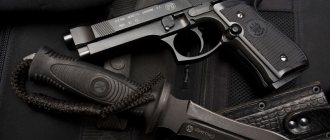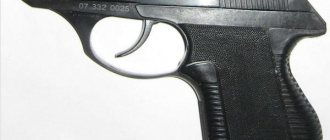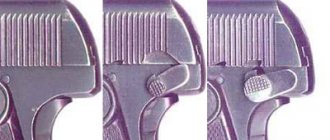TK (Korovin pistol) caliber 6.35 mm. Device. Weight. Dimensions
TK (Tula, Korovina, GAU Index - 56-A-112) - the first Soviet serial self-loading pistol. Few of our contemporaries manage to hold a Korovin TK pistol of the 1926 model in their hands, because this weapon is very rare today. All the more interesting for our readers will be the opinion about the TK of our author, Lieutenant Colonel Yuri Vasilyev, who discovered such a pistol in one of the caches in Chechnya.
Design
The Korovin pistol is a short-barreled weapon equipped with a trigger mechanism with a striker. The barrel is locked by the weight of the bolt and the return spring.
A number of weapon parts have a dual purpose, due to this it was possible to simplify the design and reduce the number of elements to 26 pieces (with complete disassembly).
To increase the weight of the shutter, its connection to the outer casing was used. To simplify manufacturing, the dimensions of the casing are reduced. The handle of Korovin’s pistol housed a replaceable box-shaped magazine designed to accommodate eight rounds. The ninth cartridge was in the chamber cavity.
The magazine lock is made in the form of a latch mounted on the lower end of the handle. There is a rotary safety on the left side of the frame that limits the movement of the trigger.
The front sight is made as a single unit with the barrel, the barrel bore has six rifling directed to the right side. The sighting device has no adjustments. The barrel part has a recess located closer to the chamber. The notch is used to rigidly connect the barrel and frame using the safety axis. There are grooves on the axis that are used to support the guide rod of the return spring. It is used to hold the safety in place and secure it in its extreme positions.
The frame is designed to hold and connect all parts of the weapon; it is made by casting followed by machining.
The return spring is mounted on a stem located under the barrel. The rear part of the cartridge ejector serves as an indicator device, informing about the presence of a cartridge in the chamber.
The main technical characteristics of the weapon are given below. The heavy weight of the weapon is noteworthy. Due to this, it was possible to provide a large resource of parts.
| Parameter | TK |
| Barrel length, mm | 67,5 |
| Length of the rifled section of the barrel, mm | 52 |
| Length, mm | 127 |
| Height, mm | 98 |
| Thickness, mm | 24 |
| Weight without cartridges/with cartridges, kg | 0,41/0,49 |
| Empty magazine weight, g | 33 |
The disadvantages of the Korovin pistol are the significant dispersion of bullets when firing, as well as the inconvenient ergonomics of the handle. The fuse had low reliability; there were cases of spontaneous shots due to the striker jumping off the combat platoon.
Pistol TK - video
Not much information can be found in modern weapons literature about weapons such as the Korovin pistol. All publications about it are similar to one another, and repeat the same information: caliber, weight, dimensions, firing range, general structure, interaction of parts and mechanisms. One gets the impression that the authors, while working on these materials, held in their hands only the “Manual on Shooting” on the Korovin pistol, but not the weapon itself. I, an experienced officer, have never met a person who could share personal impressions of the use and combat use of this now rare pistol. It turns out that the fairly well-known and at one time quite widespread TC has today become a real rarity.
As a lover of short-barreled firearms, I have long been interested in the following characteristics and qualities of this pistol: how accurate is its action, how trouble-free and reliable is it, is it safe to use? Who is this gun, a reliable friend or a capricious toy? And what is his character? After all, as you know, any type of weapon has its own, unique features. The opportunity to get acquainted with this pistol and even shoot with it came to me completely unexpectedly. Moreover, this happened under quite interesting circumstances. We destroyed a gang of militants in the mountains of Chechnya, destroyed their camp, seized weapons, documents and personal belongings of the bandits. A TK pistol was found in one of the backpacks with things abandoned by the bandits. Its entire ammunition consisted of five German-made cartridges located in the pistol’s magazine. This made it possible, at least to some extent, to study this weapon and fire a few shots from it. I would like to tell you about the impression I received when meeting this “trunk” and the opinion I formed about it.
When and why was TC created?
The TK pistol was developed by Soviet designer Sergei Aleksandrovich Korovin. In his youth, he worked for several years at the John Browning arms factory in Liege, Belgium. In 1920, he began working as a weapons designer at the Tula arms factory. It is believed that the TK pistol was originally created by him as a sports weapon and was ordered by the Dynamo sports society. This assumption may be surprising, because Korovin’s pistol is completely different from a sporting weapon. It is enough to look at it to understand that the Korovin is not at all a pistol from which you can learn to shoot well. In order to understand this, it is not at all necessary to be a great expert in weapons matters. It turns out that they ordered Sergei Alexandrovich one thing, but he did something completely different. And then the weapons he produced were put to good use.
Serial production of the pistol began in 1926. It was produced at the Tula Arms Factory, and had the official name “Tula Pistol, Korovin, Model 1926.” This weapon had a caliber of 6.35 mm, which was not typical for Russia. Over time, the production of ammunition for this pistol was established in the Soviet Union. Considering the strength and sufficient reliability of the TK, the amount of gunpowder in Soviet-made cartridges was increased. Thanks to the enhanced charge, the Korovin received certain advantages in combat power compared to some other pistols of the same caliber. It was produced from 1926 to 1935. I have never come across an exact figure for the number of TK pistols manufactured; many sources indicate that several tens of thousands of them were made. Judging by the numbers, this figure could be approximately 300,000 copies.
The TK in the Soviet Union was considered a “civilian” type of weapon. Here you can think about what citizen of the USSR in the late twenties and early thirties could afford to become the owner of this pistol? It turns out that the command staff of the Red Army, the NKVD, and the leadership of party and economic organizations were armed with the TK pistol. It was often awarded to participants in the Stakhanov movement and shock workers of socialist labor. Since it was used by people of such diverse professions, the requirements for the TC were somewhat different than for purely military weapons. And yet, we should not forget that this was the first model of a pistol developed and put into mass production in the Soviet Union, when the country's industry was just beginning to recover from the devastation. At one time, the Korovin was not a very rare weapon and was encountered relatively often. This can be judged by the fact that now it can often be found as an exhibit in many museums across the country. For example, in the museum exhibition of the Brest Fortress there is a TC with traces of damage on the frame. And in the Podolsk Museum of the Great Patriotic War there is also an interesting specimen - “Korovin”, made by some of our soldiers from clay, and then baked in the stove. This clay TC was found by searchers at battle sites.
First impressions of the Korovin pistol
It is incorrect to compare the TK with pistols that were in service with the Soviet army and those currently in service with the Russian army. How can you compare TC, for example, with PM or TT? These are completely different weapons in almost all respects. At first glance, the PSM could be considered equal to the Korovin in its tasks, capabilities and dimensions. But PSM is a completely different time, technology, and design. Therefore, it would be logical to compare the TK only with pistols that are similar to it in terms of tasks, dimensions and ammunition used in them. Such, for example, as the "Browning" model 1906, "Mauser" model 1910, "Mauser" VTP - 1 and "Mauser" VTP - 2. But for this you need to have them alive, which is currently problematic.
The TK pistol has a nondescript appearance and a rather archaic design. Even if you wanted to, you couldn’t call it elegant. Outwardly, it is somewhat similar to the civilian model of the Mauser, model 1910, which was quite popular in Europe, from which it inherited not only its original “appearance”, but also some design elements. Moreover, this “Mauser” looks even stranger if a similar term is applied to a weapon. Over time, you get used to the appearance of TK, and you even begin to like him. As for the size of the pistol, if you approach it as a civilian weapon, its dimensions and weight are quite acceptable. For a small-sized pistol, such as a ladies' or vest's one, it is too big and too heavy. In any case, in the side pocket of a jacket, or in a trouser pocket, it is visible very well.
The pistol lies quite comfortably in the hand, thanks to the well-chosen dimensions of the handle and its angle of inclination. When holding the TK, the little finger does not cover the handle, but is located under it due to its insufficient length. This feature takes some getting used to, especially after using pistols with other grip sizes. But this drawback is inherent in many small-sized pistols. The location of the safety seemed insufficiently convenient, placed too far forward on the frame of the pistol. Therefore, it is possible to switch the safety lever with the thumb of your right hand when the pistol is in it, but to do this you need to remove the pistol from the line of fire and change its position in the palm, turning the left side towards you.
I didn't like the sights. While the semicircular front sight on the barrel was of normal size, the rear sight on the bolt was somehow “underdeveloped.” Through its very small slot it was difficult to see the front sight when pointing the weapon at the target. But, most likely, for such a weapon, the firing range of which is only a few meters, the issue of rear sight size should not be considered particularly important.
The extractor is located in an unusual place - on top of the bolt. By its position, you can determine the presence of a cartridge in the chamber, both visually and by touch. This is convenient and can undoubtedly be considered an advantage of the weapon. When fired, the cartridge case is thrown clearly upward and slightly back, which turns out to be unexpected and unusual. The bolt twitches, and the cartridge is sent into the chamber easily, without much effort. The shutter stroke is short and the return spring is soft. It feels like you're dealing with a child's toy gun. The vertical notch on the bolt is deep, so the fingers do not break off when cocking the bolt. The pistol magazine is fixed with a stopper located at the lower end of the handle, just like the Makarov. But to release the stopper when replacing the magazine, much less force is required than with the PM, since the spring of the TK stopper is much weaker. Changing the magazine itself does not cause any difficulties and is done quickly, but for this you have to use both hands, and you also need to remove the pistol from the line of fire.
The trigger travel is short, the trigger itself is very soft. When there is no cartridge in the chamber, when you press the trigger, you can hear a faint and pleasant click of the striker in the bolt. Of course, in order to understand your feelings when shooting a pistol and evaluate its combat, five rounds is not enough. But, nevertheless... The shot sounds, if not very loud, then quite bitingly. When fired, the pistol jumps slightly in the hand, but at the same time the barrel sharply lifts up. After which he easily returns to the aiming line. The shutter, moving along the frame when firing, does not create such a loud clanging sound as that of the PM. I must admit that shooting from the TK is quite pleasant.
We fired the first two shots at a distance of twenty-five meters at a regular pistol target. Their results gave me a lot to think about. One of two things happened: either the shooter himself was not yet accustomed to the weapon and did not take into account its features, or, most likely, the TK pistol was not intended for shooting at such a range. The next three shots were fired at a distance of twelve meters at the same target, and, with careful aiming, gave a completely acceptable result. So for shooting from a TK, the most suitable range can be considered the distance of an outstretched arm!
Advantages and disadvantages of TC
I would like to note right away that I was unable to identify any obvious advantages in this pistol. I only noticed the simplicity of its design and ease of disassembly and assembly. But there were any number of shortcomings. Much has already been said and written about weak ammunition, low muzzle velocity and its low stopping effect, insufficient muzzle energy. We can probably agree with these comments. The battle at TK really turned out to be weak, but no one expected anything different. It was immediately clear that this pistol would not show any special capabilities when shooting. Its main shortcomings lie in a different design plane.
There is no self-cocking in the pistol, as it is not provided for by the design. This can be considered a serious flaw, significantly reducing the capabilities of the weapon. Also, the design does not provide for a trigger that hits the firing pin when fired. Here the firing pin breaks the cartridge primer under the influence of the mainspring. I had to read that this design feature is considered an advantage of this weapon, since when fired, the trigger does not hit the back of the pistol frame, and this has a good effect on the accuracy and accuracy of fire. But this dignity is perhaps far-fetched. What kind of accuracy can we talk about for a weapon that shoots relatively effectively at only about fifteen meters?
But in terms of weapon safety, the lack of a trigger is a drawback, and a significant one at that. If there is no longer a need to fire, the hammer could be removed from the cocking position, leaving the cartridge in the chamber, and the pistol could be safely put in a pocket or placed in a holster. You need to shoot - cock the trigger, and the weapon is ready for battle again. It is quite natural that the presence of a self-cocking mechanism and trigger would complicate the design of the pistol, but at the same time would significantly increase its combat capabilities and safety in handling.
The most important, in my opinion, disadvantage of this weapon lies precisely in the fact that it cannot be used suddenly. It takes time to prepare it for opening fire. To do this, the TC needs to be removed and, having jerked the bolt, cock the firing pin and fire the cartridge into the chamber. Only then can you fire a shot. If there is an experienced opponent in front of you, then he may not give you time for all this. Keeping a pistol cocked and with a cartridge in the chamber is very dangerous for the owner of the weapon, even if the safety is on.
When the safety is on, it only blocks the trigger. But this measure cannot be considered sufficient, since if the pistol is dropped, or if it is sharply shaken or hit, the firing pin may be decocked, and, accordingly, an involuntary shot may occur. For this purpose, he even conducted an experiment: he unloaded the weapon, then, jerking the bolt, cocked it and deliberately dropped it on the floor. In at least half of the cases, when the pistol was hit, the firing pin was decocked. And here, most likely, it’s not even a matter of old age and severe wear and tear of the pistol. The danger when handling it is determined by its very design.
Now I would like to talk directly about the TC that fell into our hands as a battle trophy. It may have been in the ground for a long time or stored in very poor conditions. There were quite deep shells all over its surface. His Chechen owners tried to restore the blueing of the pistol. But it didn’t turn out very well for them. Some small parts, such as the safety, trigger axis and sear axis were homemade, made on milling and lathes. Apparently, these original parts were either lost or broken during the use of the weapon. The plastic handle linings were also not factory made, but homemade. After the available cartridges for it were used up, and everyone had played enough with it, this TK was handed over to the weapons depot and carried out according to the book of registration of captured weapons. And I only have a few photographs of this pistol as a keepsake, taken by me at a time when the pistol had already been broken during “experiments” and some of its parts were lost.
Some conclusions and assessments
Even after such a short acquaintance, it was not at all difficult to evaluate “Korovin”. He didn’t make any special impression and didn’t cause any enthusiasm. Its low combat value was immediately obvious. In a combat situation, this weapon is practically useless and is not even suitable for use as an additional weapon. And the point here is not its small caliber, as well as weak and scarce ammunition. The main reason for this is that it cannot be used immediately and it takes time to prepare it for firing. Having a constantly loaded and cocked weapon with you is very unsafe. So, in essence, it is just more of a dangerous toy than a weapon.
In principle, it may well be suitable for the category of people who were used at one time: the highest level of party and economic officials, generals of the Red Army and the NKVD. It is also suitable for Stakhanovites and shock workers of socialist labor as awards and gifts. And it’s also suitable for being among other necessary things in a handbag. True, the TK is too large and heavy for a woman’s pen; now there are a sufficient number of more compact and lighter samples. It might also come in handy for a night robber. Especially if it would be possible to do without shooting, but only by threatening the frightened victim with it. In short, this weapon is for all those who want to have something small and shoot with them, but are not going to shoot from this weapon, much less fight with it.
Gunsmith Korovin
S. A. Korovin during the revolution of 1905−1907. was expelled from the Technological Institute in Kharkov and went abroad. The future gunsmith moved to Belgium, where he got a job at the Browning arms factory in Liege. Having already had some experience in design activities, in 1914 Korovin returned to Russia and several times tried to get a job at the Tula Arms Plant, but was regularly refused. Only at the end of the Civil War Korovin managed to begin design activities in Tula. In 1923, he created a pistol chambered for the 7.65 mm Browning cartridge. However, this model was not accepted for service. This weapon was distinguished by a significant degree of reliability and safety in operation, but was complex and labor-intensive to produce.
S. A. Korovin. (sitekid.ru)
Photo of the TK pistol
Similar
AK-47 assault rifle cartridge caliber 7.62 mm.
Device. Rate of fire AK-74 assault rifle cartridge 5.45 mm caliber. Device. Rate of fire
Dragunov SVD sniper rifle caliber 7.62 mm. Device
AKS-74U assault rifle cartridge caliber 5.45 mm. Device. Weight
Mauser K96 pistol cartridge caliber 7.63 and 9 mm. Device
Pistol Walter PP / PPK cartridge caliber 7.65 and 9 mm. Device
Pistol Yarygin PYa Grach cartridge caliber 9 mm. Device
DShK machine gun cartridge caliber 12.7 mm. Device. Rate of fire
Luger pistol R.08 Parabellum cartridge caliber 9 mm. Device
Pistol PM cartridge caliber 9 mm. Rate of fire. Dimensions. Bullet speed. Sighting range
Self-loading shotgun Saiga-12 cartridge, caliber. Device
Maxim machine gun cartridge caliber 7.62 mm. Device. Weight
PPSh-41 Shpagina submachine gun cartridge caliber 7.62 mm
APS Stechkin pistol cartridge caliber 9 mm. Device
Nagan system revolver cartridge caliber 7.62 mm. Device
Kalashnikov PK machine gun and PKM cartridge caliber 7.62 mm. Device
Simonov carbine SKS-45 cartridge caliber 7.62 mm. Device
Rifles and carbines Mauser 98 caliber 7.92 mm. Device
PPS-42 and PPS-43 Sudaev submachine gun cartridge caliber 7.62 mm
Pistol Walter P38 cartridge caliber 9 mm. Device
MP-40 German submachine gun cartridge caliber 9 mm. Device
VSS Vintorez sniper rifle caliber 9 mm. Device
Submachine gun PP-91 Kedr cartridge 9 mm caliber. Device
Light machine gun RPK-74 cartridge caliber 5.45 mm. Device
Pistol Glock 17 cartridge caliber 9 mm. Device
Makarych, Izh-79-9T, MR-79-9TM, MP-80-13T traumatic pistol
AK-12 assault rifle cartridge caliber 5.45 mm. Device. Weight
Mosin rifles and carbines Three-line caliber 7.62 mm
PMM Makarov pistol modernized 12 rounds. Device
Revolver Colt Single Action Army (SAA) Peacemaker. Device
Machine gun PKP Pecheneg cartridge caliber 7.62 mm. Device
Sniper rifle VSSK Exhaust caliber 12.7 mm. Device
Beretta pistol 92 cartridge caliber 9 mm. Device
TT - Tokarev pistol cartridge caliber 7.62 mm. Device
Submachine gun PP-19 Bison cartridge caliber 9 and 7.62 mm. Device
Sniper rifle SV-98 caliber 7.62 mm. Device
Vladimirov KPV machine gun cartridge caliber 14.5 mm. Device
ASH-12 assault rifle cartridge caliber 12.7 mm. Device. Rate of fire
PSM pistol cartridge caliber 5.45 mm. Device
Pistol Colt M1911A1 cartridge caliber 45. Device
Smith-Wesson revolver Russian cartridge, caliber 10.67 mm. Device
Degtyarev DP-27 light machine gun, 7.62 mm caliber cartridge. Device
Shotgun Mossberg 500 Cartridge. Dimensions. Rate of fire. Sighting range
Thompson submachine gun cartridge caliber 11.43 mm. Device
Pistol USP Heckler und Koch cartridge, caliber. Device
Hunting carbine OSK-88 (SVT-40) caliber 7.62 mm. Device
AS Val silent automatic cartridge caliber 9 mm. Device
Submachine gun PP-19-01 Vityaz cartridge 9 mm caliber. Device
Machine gun Kord cartridge caliber 12.7 mm. Device. Weight. Sighting range
Osa - traumatic pistol cartridge, caliber. Device
AK-9 assault rifle cartridge caliber 9 mm. Device. Rate of fire
Degtyarev RPD light machine gun, 7.62 mm caliber cartridge. Device
Automatic OTs-14 Groza cartridge caliber 9 mm and 7.62 mm. Device
Czech pistol CZ-75 (modifications). Device
Browning pistol 1903 cartridge caliber 9 mm. Device
Sniper rifle OSV-96 caliber 12.7 mm. Device
FN P90 submachine gun cartridge caliber 5.7 mm. Device
Submachine gun OTs-02 Cypress cartridge caliber 9 mm. Device
Sniper rifle ASVK Kord caliber 12.7 mm. Device
Automatic AEK-971 Cartridge. Caliber. Device. Rate of fire
Steyr AUG assault rifle (A1, A2, A3) cartridge caliber 5.56 mm
AK series 100 assault rifles. Modifications. Device. Weight. Dimensions
Uzi submachine gun. Cartridge. Caliber. Rate of fire
Pistol SR1M Gyurza cartridge caliber 9 mm. Device
Pistol GSh-18 cartridge caliber 9 mm. Device
SVDK sniper rifle caliber 9.3 mm. Device
Automatic SR-3M Whirlwind cartridge caliber 9 mm. Device
Machine gun NSV-12.7 Utes cartridge, cal. Device. Weight
Kalashnikov RPK light machine gun cartridge caliber 7.62 mm. Device
Sniper rifle VSK-94 caliber 9 mm. Device
Vostok-1 (Jorge-3M) 9mm caliber traumatic pistol. Device
Degtyarev PPD submachine gun cartridge caliber 7.62 mm
English sniper rifle L96A1 cartridge, caliber
M1 Garand rifle cartridge caliber 7.62 mm. Device
Desert Eagle pistol. Device
Smith-Wesson revolver (modifications). Device
Automatic rifle HK G36 (E, K, C, KE) cartridge caliber 5.56 mm
Pistol P-96 cartridge caliber 9 mm. Device. Rate of fire
Pistol GP35 Browning High Power cartridge, caliber. Device
Assault rifle FN SCAR (L, H) cartridge caliber 5.56 and 7.62 mm
Revolver Lefoshe M1856 cartridge caliber 11 mm. Device
Submachine gun PP-90 cartridge caliber 9 mm. Device
AN-94 Abakan automatic Nikonov cartridge caliber 5.45 mm. Device
Submachine gun PP-2000 cartridge caliber 9 mm. Device
Mauser pistol HSc cartridge caliber 7.65 and 9 mm. Device
M16 automatic rifle cartridge caliber 5.56 mm. Device
Fedorov assault rifle cartridge caliber 6.5 mm. Device. Rate of fire
Pistol Baltiets cartridge caliber 7.62 mm. Device
Strizh pistol cartridge caliber 9 mm. Device. Weight. Sighting range
Browning pistol 1910 cartridge caliber 7.65 and 9 mm
Silent pistol PSS Vul cartridge caliber 7.62 mm. Device
Pistol SIG-Sauer P226 cartridge caliber 9 mm. Device
Pistol OTs-27 Berdysh cartridge caliber 7.62 mm and 9 mm. Device
AK-107 assault rifle cartridge caliber 5.45 mm. Device. Rate of fire
OTs-44 sniper rifle, caliber 12.7 mm. Device
German machine gun MG3 cartridge caliber 7.62 mm. Device
Self-loading shotgun Browning Auto-5 cartridge, caliber. Device
Submachine gun AEK-919K Kashtan cartridge caliber 9 mm. Device
PB pistol silent cartridge 9 mm caliber. Device
Pistol OTs-33 Pernach cartridge caliber 9 mm. Device
Hunting carbine KO-98 cartridge caliber 7.92 mm. Device
TK (Korovin pistol) caliber 6.35 mm. Device. Weight. Dimensions
Underwater assault rifle APS cartridge caliber 5.66 mm. Device
Pistol OTs-21 Malysh cartridge caliber 9 mm. Device
American M60 machine gun, 7.62 mm caliber cartridge. Device
MTs-116M sniper rifle, caliber 7.62 mm. Device
Automatic 9A-91 cartridge caliber 9 mm. Device. Rate of fire
Submachine gun PP-93 cartridge caliber 9 mm. Device
VAG-73 - Gerasimenko pistol. Device. Weight. Dimensions
Cordon-5 is a traumatic pistol. Device. Weight. Dimensions
Goryunov SG-43 heavy machine gun cartridge caliber 7.62 mm. Device
Webley revolver cartridge, caliber. Device. Dimensions. Weight
Machine gun AEK-999 Badger cartridge caliber 7.62 mm. Device
RP-46 machine gun, 7.62 mm caliber cartridge. Device. Rate of fire
Sniper rifle VS-8 cartridge caliber 8.6 mm. Device
Slostin machine gun cartridge caliber 7.62 mm and 14.5 mm. Device
Assault rifle Tavor TAR-21 cartridge caliber 5.56 and 5.45 mm
Submachine gun SR-2 Veresk cartridge caliber 9 mm. Device
Lancaster pistol cartridge caliber 12.1 mm. Device. Rate of fire
Submachine gun PP-90M1 cartridge caliber 9 mm. Device
Underwater pistol SPP-1M. Device. Weight. Dimensions
Traumatic pistol MP-461 Guard. Device. Weight. Dimensions
Lebel rifles and carbines are cartridgeed in 8 mm caliber. Device
Automatic A-91 cartridge caliber 7.62 mm. Device. Rate of fire
M14 automatic rifle cartridge caliber 7.62 mm. Device
Revolver Smith & Wesson Model 10 Military & Police
Automatic rifle FN FAL cartridge caliber 7.62 mm. Device
Submachine gun STEN MK 2. Device. Weight. Dimensions
Traumatic pistol IZH-78-9T Chain mail cartridge caliber 9 mm
Leader-M traumatic pistol 11.43×32T. Device. Weight. Dimensions
Ingram M10 and M11 submachine gun. Device. Weight. Dimensions
Pistol Steyr M9-A1 cartridge caliber 9 mm. Device. Weight
Pistol OTs-23 Dart cartridge caliber 5.45 mm. Device
Berthier rifles and carbines caliber 8 mm. Device
Automatic shotgun USAS-12 cartridge caliber 18.5 mm
Sniper rifle VS-121 caliber 7.62 mm. Device
Traumatic pistol MP-353 cartridge, caliber 11.43 mm
Tiss machine gun cartridge caliber 9 mm. Device. Rate of fire
Traumatic pistol MP-355 cartridge caliber 9 mm. Device
Automatic double-medium ADS cartridge caliber 5.45 mm. Device. Rate of fire
Traumatic pistol MP-81 cartridge caliber 9 mm. Device
Pistols Zastava 70 and 70(k), cartridge caliber 7.65 or 9 mm. Yugoslavia
Sniper rifle GALATZ (Galil) cartridge caliber 7.62 mm
Pistol MP-444 Bagheera cartridge caliber 9 mm. Device
Revolver Colt New Army / Navy. Device. Bullet speed. Sighting range
Type 64 is a Japanese automatic rifle. Device
Application and interesting facts
The Korovin pistol was used to a limited extent by members of the NKVD, as well as by the command staff of the Red Army. In addition, individual copies were awarded as award weapons to employees of internal affairs bodies, heads of large enterprises and design bureaus, as well as Stakhanovites. The pistol was not used as a self-defense weapon for civilians.
During the Great Patriotic War, some of the barrels that were in storage entered the active army. The weapon was used to arm junior command personnel (due to the shortage of the main TT pistol).
After the end of the war, Korovin’s pistol was used as a backup weapon for employees of State Bank branches or savings banks (including collectors).
The domestic cartridge size 6.35*15.5 mm appears in the film “The meeting place cannot be changed.” It was with this that the Bayard pistol that the doctor Gruzdev had was loaded.
The energy of Korovin’s pistol bullets was enough to guarantee through penetration of 2 pine boards 25 mm thick from a distance of 25 m. After this, the bullet half pierces the third board.
The commander of the 33rd Army, M.G., was armed with a Korovin pistol. Efremov during an attempt to break out of encirclement in the spring of 1942.
The reason for the short life cycle of the TK pistol was the low power of the cartridge and the lack of demand for this type of weapon in the USSR. The army used the pistol only during a period of acute shortage of more reliable and powerful TTs. Hitting a target with a 6.35 mm bullet did not guarantee the shooter's safety, since the attacker could strike back.
The only effective way to use a TK in combat was to shoot at the enemy’s head, which not every owner of a Korovin pistol was able to do. To date, many samples of weapons have been preserved, in varying states of preservation. But regardless of condition, the TK is a desirable acquisition for many gun collectors.

